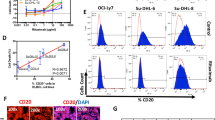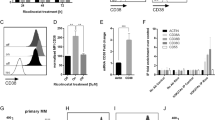Abstract
Object Apoptosis, a key cellular response to therapeutic agents is often inactivated in tumor cells. In this study, we evaluated the expression of the tumor necrosis family of death receptors, DR4 and DR5, in medulloblastoma tumor samples and cell lines to determine if epigenetic modulation of gene expression could sensitize tumor cell lines to TRAIL-mediated apoptosis. Methods Human medulloblastoma samples and cell lines were analyzed for DR4 and DR5 expression by quantitative PCR and immunofluorescence assays. Cell lines with downregulated expression of one or both genes were treated with the histone deacetylase inhibitor, MS-275, and the expression of DR4 and DR5 measured by quantitative PCR, Western blotting, flow cytometry and chromatin immunoprecipitation assays. Induction of apoptosis in the presence of MS-275 was evaluated by TUNEL assay and its ability to augment TRAIL-mediated cytotoxicity was determined by MTT assays, Western blotting and flow cytometry. Results Compared to normal cerebellum, DR4, but not DR5 expression was consistently downregulated in medulloblastoma tumor samples and in Daoy and D283 cell lines. Interestingly, MS-275 decreased cell growth and induced apoptosis in Daoy and D283 cells. In Daoy cells, this coincided with increased histone H3 and H4 acetylation at the DR4 promoter and enhanced DR4 gene and protein expression as well as elevated Caspase-8 activity. The involvement of DR4 in the cellular response to MS-275 was further confirmed by the observation that knockdown of DR4 and FADD abrogated apoptosis. Further, addition of TRAIL to MS-275 treated cells resulted in an enhancement of apoptosis, suggesting that the upregulated death receptors were functional. Conclusion Our study provides an understanding of the role of DR4 in apoptosis of medulloblastoma cell lines and suggests a potential contribution of aberrant histone deacetylation to the resistance of medulloblastoma cells to therapeutic death.









Similar content being viewed by others
Abbreviations
- FADD:
-
FAS-associated death domain
- MTT:
-
3-(4, 5 dimethylthiazole-2yl)-5-(3-carboxymethoxyphenyl)-2-(4-sulfophenyl)-2H-Tetrazolium
- TRAIL:
-
TNF-related apoptosis-inducing ligand
- MS-275:
-
N-(2-aminophenyl)-4-[(N-pyridine-3-ylmetoxycarbonyl) aminomethyl] Benzamide
References
Louis DN, Ohgaki H, Wiestler OD et al (2007) The 2007 WHO classification of tumours of the central nervous system. Acta Neuropathol 114:97–109. doi:10.1007/s00401-007-0243-4
Eberhart CG, Burger PC (2003) Anaplasia and grading in medulloblastomas. Brain Pathol 13:376–385
Packer RJ, Goldwein J, Nicholson HS et al (1999) Treatment of children with medulloblastomas with reduced-dose craniospinal radiation therapy and adjuvant chemotherapy: a Children’s Cancer Group Study. J Clin Oncol 17:2127–2136
Askenazi A, Dikshit VM (1998) Death receptors: signaling and modulation. Science 281:1305–1308. doi:10.1126/science.281.5381.1305
Ozoren N, El-Deiry WS (2003) Cell surface death receptor signaling in normal and cancer cells. Semin Cancer Biol 13:135–147. doi:10.1016/S1044-579X(02)00131-1
Bolden JE, Peart MJ, Johnstone RW (2006) Anticancer activities of histone deacetylase inhibitors. Nat Rev Drug Discov 5:769–784. doi:10.1038/nrd2133
Marks P, Rifkind RA, Richon VM, Breslow R, Miller T, Kelly WK (2001) Histone deacetylases and cancer: causes and therapies. Nat Rev Cancer 1:194–202. doi:10.1038/35106079
Esteller M (2008) Epigenetics in cancer. N Engl J Med 358:1148–1159. doi:10.1056/NEJMra072067
Pingoud-Meier C, Lang D, Janss AJ et al (2003) Loss of caspase-8 protein expression correlates with unfavorable survival outcome in childhood medulloblastoma. Clin Cancer Res 9:6401–6409
Zuzak TJ, Steinhoff DF, Sutton LN, Phillips PC, Eggert A, Grotzer MA (2002) Loss of caspase-8 mRNA expression is common in childhood primitive neuroectodermal brain tumour/medulloblastoma. Eur J Cancer 38:83–91. doi:10.1016/S0959-8049(01)00355-0
Ebinger M, Senf L, Wachowski O, Scheurlen W (2004) Promoter methylation pattern of caspase-8, P16INK4A, MGMT, TIMP-3, and E-cadherin in medulloblastoma. Pathol Oncol Res 10:17–21
Gonzalez-Gomez P, Bello MJ, Inda MM et al (2004) Deletion and aberrant CpG island methylation of caspase 8 gene in medulloblastoma. Oncol Rep 12:663–666
Lindsey JC, Lusher ME, Anderton JA et al (2004) Identification of tumour-specific epigenetic events in medulloblastoma development by hypermethylation profiling. Carcinogenesis 25:661–668. doi:10.1093/carcin/bgh055
Fulda S, Debatin KM (2006) 5-Aza-2′-deoxycytidine and IFN-gamma cooperate to sensitize for TRAIL-induced apoptosis by upregulating caspase-8. Oncogene 25:5125–5133. doi:10.1038/sj.onc.1209608
Muhlisch J, Bajanowski T, Rickert CH et al (2007) Frequent but borderline methylation of p16 (INK4a) and TIMP3 in medulloblastoma and sPNET revealed by quantitative analyses. J Neurooncol 83:17–29. doi:10.1007/s11060-006-9309-8
Riffkin CD, Gray AZ, Hawkins CJ, Chow CW, Ashley DM (2001) Ex vivo pediatric brain tumors express Fas (CD95) and FasL (CD95L) and are resistant to apoptosis induction. Neuro-oncol 3:229–240. doi:10.1215/15228517-3-4-229
Antonov J, Goldstein DR, Oberli A et al (2005) Reliable gene expression measurements from degraded RNA by quantitative real-time PCR depend on short amplicons and a proper normalization. Lab Invest 85:1040–1050. doi:10.1038/labinvest.3700303
Sinnapah-Kang ND, Mrak RE, Paulsen DB, Marchetti D (2006) Heparanase expression and TrkC/p75NTR ratios in human medulloblastoma. Clin Exp Metastasis 23:55–63. doi:10.1007/s10585-006-9017-y
Chen CY, Shyu AB (1995) AU Rich elements: characterization and importance in mRNA degradation. Trends Biochem Sci 20:465–470. doi:10.1016/S0968-0004(00)89102-1
Kuijlen JM, Mooij JJ, Platteel I et al (2006) TRAIL-receptor expression is an independent prognostic factor for survival in patients with a primary glioblastoma multiforme. J Neurooncol 78:161–171. doi:10.1007/s11060-005-9081-1
Horak P, Pils D, Haller G et al (2005) Contribution of epigenetic silencing of tumor necrosis factor-related apoptosis inducing ligand receptor 1 (DR4) to TRAIL resistance and ovarian cancer. Mol Cancer Res 3:335–343. doi:10.1158/1541-7786.MCR-04-0136
van Noesel MM, van Bezouw S, Voute PA, Herman JG, Pieters R, Versteeg R (2003) Clustering of hypermethylated genes in neuroblastoma. Genes Chromosomes Cancer 38:226–233. doi:10.1002/gcc.10278
van Geelen CM, deVries EG, Le TK, van Weeghel RP, deJong S (2003) Differential modulation of the TRAIL receptors and CD95 in colon carcinoma. Br J Cancer 89:363–373. doi:10.1038/sj.bjc.6601065
Suzuki M, Shigematsu H, Shivapurkar N et al (2006) Methylation of apoptosis related genes in the pathogenesis and prognosis of prostate cancer. Cancer Lett 242:222–230. doi:10.1016/j.canlet.2005.11.002
Bae SI, Cheriyath V, Jacobs BS, Reu FJ, Borden EC (2008) Reversal of methylation silencing of Apo2L/TRAIL receptor 1 (DR4) expression overcomes resistance of SK-MEL-3 and SK-MEL-28 melanoma cells to interferons (IFNs) or Apo2L/TRAIL. Oncogene 27:490–498. doi:10.1038/sj.onc.1210655
Bachman KE, Park BH, Rhee I et al (2003) Histone modifications and silencing prior to DNA methylation of a tumor suppressor gene. Cancer Cell 3:89–95. doi:10.1016/S1535-6108(02)00234-9
Boldin MP, Mett IL, Varfolomeev EE et al (1995) Self-association of the “death domains” of the p55 tumor necrosis factor (TNF) receptor and Fas/APO1 prompts signaling for TNF and Fas/APO1 effects. J Biol Chem 270:387–391. doi:10.1074/jbc.270.1.387
Sonneman J, Kumar KS, Heesch S et al (2006) Histone deacetylase inhibitors induce cell death and enhance susceptibility to ionizing radiation, etoposide and TRAIL. Int J Oncol 28:755–766
Ravi R, Bedi GC, Engstrom LW, Zeng Q, Mookerjee B, Gelinas C, Fuchs EJ, Bedi A (2001) Regulation of death receptor expression and TRAIL/Apo2L-induced apoptosis by NF-kappaB. Nat Cell Biol 3:409–416. doi:10.1038/35070096
Guan B, Yue P, Lotan R, Sun SY (2002) Evidence that human death receptor protein 4is regulated by activator protein 1. Oncogene 21:3121–3129. doi:10.1038/sj.onc.1205430
Liu X, Yue P, Khuri FR, Sun SY (2004) p53 Upregulates death receptor 4 expression through an intronic p53 binding site. Cancer Res 64:5078–5083. doi:10.1158/0008-5472.CAN-04-1195
Li XN, Shu Q, Su JM, Perlaky L, Blaney SM, Lau CC (2005) Valproic acid induces growth arrest, apoptosis, and senescence in medulloblastomas by increasing histone hyperacetylation and regulating expression of p21Cip1, CDK4, and CMYC. Mol Cancer Ther 4:1912–1922. doi:10.1158/1535-7163.MCT-05-0184
Jaboin J, Wild J, Hamidi H et al (2002) MS-27-275, an inhibitor of histone deacetylase, has marked in vitro and in vivo antitumor activity against pediatric solid tumors. Cancer Res 62:6108–6115
Shu Q, Antalffy B, Su JM et al (2006) Valproic acid prolongs survival time of severe combined immunodeficient mice bearing intracerebellar orthotopic medulloblastoma xenografts. Clin Cancer Res 12:4687–4694. doi:10.1158/1078-0432.CCR-05-2849
Graham C, Tucker C, Creech J et al (2006) Evaluation of the antitumor efficacy, pharmacokinetics, and pharmacodynamics of the histone deacetylase inhibitor depsipeptide in childhood cancer models in vivo. Clin Cancer Res 12:223–234. doi:10.1158/1078-0432.CCR-05-1225
Kumar KS, Sonnemann J, Beck JF (2006) Histone deacetylase inhibitors induce cell death in supratentorial primitive neuroectodermal tumor cells. Oncol Rep 16:1047–1052
Spiller SE, Ravanpay AC, Hahn AW, Olson JM (2006) Suberoylanilide hydroxamic acid is effective in preclinical studies of medulloblastoma. J Neurooncol 79:259–270. doi:10.1007/s11060-006-9142-0
Camphausen K, Cerna D, Scott T et al (2005) Enhancement of in vitro and in vivo tumor cell radiosensitivity by valproic acid. Int J Cancer 114:380–386. doi:10.1002/ijc.20774
Camphausen K, Scott T, Sproull M, Tofilon PJ (2004) Enhancement of xenograft tumor radiosensitivity by the histone deacetylase inhibitor MS-275 and correlation with histone hyperacetylation. Clin Cancer Res 10:6066–6071. doi:10.1158/1078-0432.CCR-04-0537
Das CM, Aguilera D, Vasquez H et al (2007) Valproic acid induces p21 and topoisomerase-II (alpha/beta) expression and synergistically enhances etoposide cytotoxicity in human glioblastoma cell lines. J Neurooncol 85:159–170. doi:10.1007/s11060-007-9402-7
Banuelos CA, Banath JP, MacPhail SH et al (2007) Radiosensitization by the histone deacetylase inhibitor PCI-24781. Clin Cancer Res 13:6816–6826. doi:10.1158/1078-0432.CCR-07-1126
Nagane M, Huang HJ, Cavenee WK (2001) The potential of TRAIL for cancer chemotherapy. Apoptosis 6:191–197. doi:10.1023/A:1011336726649
Acknowledgements
We would like to thank Drs. Peter Zage, Joya Chandra and Douglas Cardillo for their input on this manuscript. We also wish to thank Dr. Ashish Kamath for sharing xenografts of bladder cancer for our analyses.
Author information
Authors and Affiliations
Corresponding author
Additional information
This work was supported in part by Award P50CA127001 from the National Cancer Institutes and Grants from the National Brain Tumor Foundation and the American Cancer Society-IRG to VG.
Rights and permissions
About this article
Cite this article
Aguilera, D.G., Das, C.M., Sinnappah-Kang, N.D. et al. Reactivation of death receptor 4 (DR4) expression sensitizes medulloblastoma cell lines to TRAIL. J Neurooncol 93, 303–318 (2009). https://doi.org/10.1007/s11060-008-9788-x
Received:
Accepted:
Published:
Issue Date:
DOI: https://doi.org/10.1007/s11060-008-9788-x




